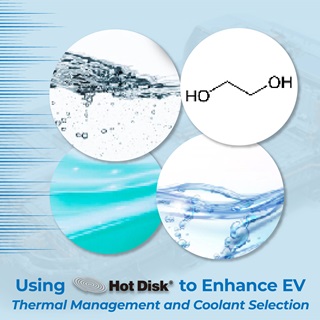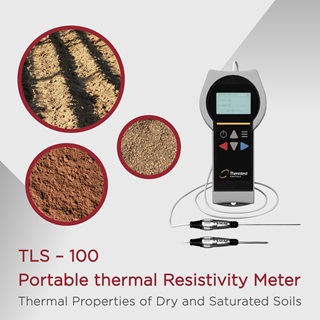- Technology Application -
08.Mar.2024
TC Measuring the Thermal Conductivity of Snow with the TLS-100
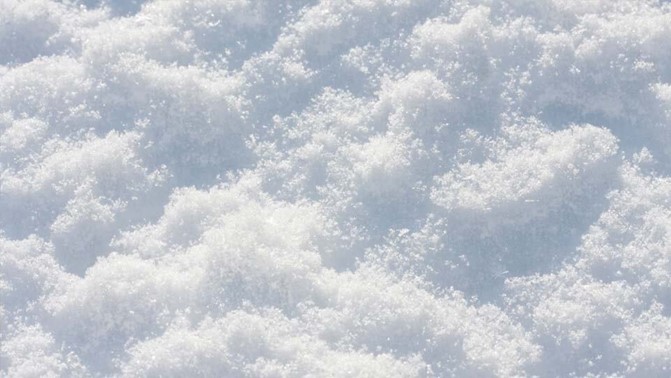
Investigating the science of snow and studying the snow pack can be a crucial element in understanding larger climate events and changes. Snow plays an important role in balancing the global climate through a variety of factors, as it covers over 46 million km2 of the Earth’s surface each year (Figure 1). The snow pack is a major barrier against incoming solar radiation, as it reflects between 80-90% of rays, and plays a role in maintaining the planets energy balance. Many lakes and rivers are replenished by the snow melt each spring. During winter months snow acts as insulation between soil, and the plants and microorganisms living in it, and the frigid winter air temperatures. Comprehending how heat is exchanged through the snow pack and the temperature gradients that exist between the air and the soil is accomplished through study of the thermal conductivity of snow.
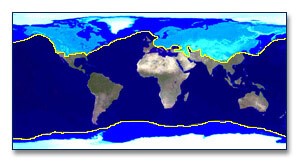
▲This image delineates the areas of the planet that receive weather cold enough to promote a snow cover each year.
The thermal conductivity of snow is often hard to pinpoint, as it is incredibly variable and can change rapidly. Density, water content, crystalline structure and grain to grain contact all affect the thermal conductivity of a snow sample. Measurements are often hard to reproduce within the same sample, as the measurement itself can alter structure and density that subsequently change the thermal conductivity. Needle probes are the most popular equipment for thermal conductivity testing on snow. In this application page we will showcase the ability of the TLS-100, Thermtest’s portable resistivity meter (Figure 2), to measure the thermal conductivity of snow.
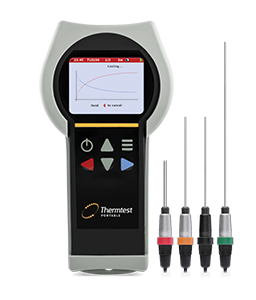
▲Thermtest’s TLS-100, a portable thermal conductivity and thermal resistivity meter.
Snow Sampling Experimental Set-Up
The TLS-100 was used to measure the thermal conductivity of both undisturbed and compacted snow. Measurements took place in-situ, in an air temperature of -4°C. For undisturbed snow sampling, the TLS probe was inserted into the snowpack in three different locations during a fresh snowfall and a measurement was taken at each site. The location was changed between each measurement to prevent snow melt caused by the sensor heating during the test to affect the next measurement. All three locations were within six inches of each other. A 10 minute delay was implemented prior to and between measurements. An evenly compacted snow sample was created by packing snow into a cylindrical sample holder. The TLS probe was inserted into the sample and performed measurements in two different locations, following the same protocol as was used for the undisturbed samples.

▲Diagrams depicting the sampling procedure used to measure the thermal conductivity of snow with the TLS-100.The illustration on the left shows the method for sampling fresh snow by inserting the needle directly into the snow pack.The illustration on right displays the thermal measurement of a cylinder of compacted snow to assess how changes in density affect the thermal conductivity.
Thermal Conductivity of Snow Samples
The thermal conductivity results produced by the TLS-100 for both undisturbed and compacted snow samples are displayed in Table 1. The thermal conductivity of the compacted snow samples, 0.432 W/mK, is much higher than that of the undisturbed snow sample (Table 1). These results illustrate the large influence that density has over the sample thermal conductivity. As with other materials, the more air that is present in a sample, the lower the thermal conductivity. When the snow is compacted and less air exists between the grains, the thermal conductivity increases. This showcases how quickly the thermal conductivity of snow can be drastically altered. Density increases can be due to wind, settling, and compaction. Human activities including snowmobiling, skiing, and snow-plowing cause large areas of compaction to occur during the winter months. The change in thermal conductivity as a result of this also changes how much heat is transferred between the atmosphere and the soil below the snow pack.
| Sample | Temperature (°C) | λ (W/m·K) | σ (W/m·K) |
| Undisturbed Snow | -4 | 0.045 | 0.002 |
| Compacted Snow | -4 | 0.432 | 0.021 |
▲Thermal conductivity of undisturbed and compacted snow samples measured in the field using the TLS-100 during December, 2015.
The results listed in Table 1 agree well with published literature on snow thermal conductivity. The TLS-100 produced a mean thermal conductivity of 0.045 W/mK for the undisturbed snow. Pomeroy and Brun (2001) also report that the thermal conductivity of undisturbed snow is 0.045 W/mK. Cote, Rahimi and Konrad report thermal conductivities for compacted snow that varied from 0.12 W/mK and 0.54 W/mK for porosities from 0.4 to 0.68 and for a temperature of -12°C. The value obtained using the TLS-100 (0.432 W/mK) falls within this range.
This field work is an excellent example of the versatility that the TLS-100 is capable of. It is a powerful tool that can be used in all seasons; on projects involving soil, rock, and snow research. The accuracy and reliability of measurements has not been compromised by the convenient, portable package, making the TLS-100 an ideal choice for thermal conductivity measurements occurring outside of the laboratory.
This field work is an excellent example of the versatility that the TLS-100 is capable of. It is a powerful tool that can be used in all seasons; on projects involving soil, rock, and snow research. The accuracy and reliability of measurements has not been compromised by the convenient, portable package, making the TLS-100 an ideal choice for thermal conductivity measurements occurring outside of the laboratory.
Learn More About Thermtest TLS-100
Thermtest’s TLS-100 presents field researchers the opportunity to measure the thermal properties of organic materials, such as soils and concrete. This instrument relies on the Transient Line Source (TLS) technique to provide efficient and accurate thermal conductivity readings of soils, powders and solids, ranging in thermal conductivities of 0.1 to 5 W/mK.
References:
References:
- Cook, B.I., Bonan, G.B., Levis, S., and Epstein, H.E. 2008. The thermoinsulation effect of snow cover within a climate model. Climate Dynamics. 31(1): 107-124.
- Côté, J., Rahimi, M., and Konrad, J. (2012) Thermal Conductivity of Compacted Snow. Cold Regions Engineering 2012: pp. 833-843
- Global Greenhouse Warming. Ecology of Snow. Available at: http://www.global-greenhouse-warming.com/ecology-of-snow.html
- National Snow and Ice Data Center. All About Snow: Snow and Climate. Available at: https://nsidc.org/cryosphere/snow/climate.html
- Pomeroy, J.W. and E. Brun (2001) Physical properties of snow In (eds. H.G. Jones, J.W. Pomeroy, D.A. Walker and R.W. Hoham) Snow Ecology: an Interdisciplinary Examination of Snow-covered Ecosystems 45 – 118p. Cambridge University Press, Cambridge, UK
- Riche, F., and Schneebeli, M. 2013. Thermal conductivity of snow measured by three independent methods and anisotropy considerations. The Cryosphere. 7: 217–227.
Photo References:
- “fresh snow” by liz west is licensed under CC BY 2.0
- http://www.nohrsc.noaa.gov/~cline/clp/description/mission_description.html
- The application note reference Thermtest documentation
| For media inquiries, please contact: Alan Li (General Manager) | |
| Email: alan.li@techmaxasia.com.hk | Phone: +852 3960 7016 |





